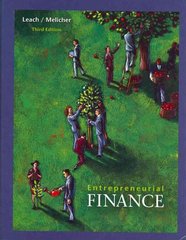Hi,
Please help me solve these questions in steps so I can understand them.
Thank you!
7. You are considering investing in a new venture. Based on the business plan of the entrepreneur, fths project is successfuL it is expected to generate the following cash ows for investors: Year Cash Flow . 1 . $0 . 2 . $200,000 . 3 . $2,000,000 . 4 . $8,000,000 The cash flow in the fourth year includes cash flows that would be realized from selling the venture to a third party at that time. After conducting your own due diligence, you have concluded that vou agree with the entrepreneur that if the venture is successful, the cash flow estimates are reasonable. The entrepreneur is looking for seed capital of $1 million to undertake the venture. After the initial investment, if it is successful, the venture will be self-supporting. Using the 50 percent to 100 percent range of hurdle rates for seed and start-up investments, estimate the present value of the venture and the fraction of the equity vou would need to cover your investment. Also, determine the hurdle rate that would result in a zero NPV for a 100 percent interest in the venture. 3. Consider problem 7 again. Through your due diligence efforts, you also have concluded that the probability that the venture will be successful through year 2 is about 80 percent, through year 3 is about 60 percent, and through year 4 is about 40 percent. If the venture fails, it will not return any cash to investors. Compute the expected cash flows of the venture and nd the discount rates of the expected cash flows that would yield the same ownership fractions as the 50 percent hurdle rate in problem 7. In other words, given the ownership fraction you would require if a hurdle rate of 50 percent is used in Problem 7, what discount rate of expected cash flows would yield a present value of the venture that would imply the same ownership fraction for your investment of $1 million (Note: Finding this rate may require some experimentation.) 9. Compare the present-value estimates of each of the annual cash flows between problems 7 and 3. What problems can you see with valuing projects using optimistic cash flow forecasts and hurdle rates, as in problem 7 instead of expected cash flow estimates and required rates of return as in problem 8








